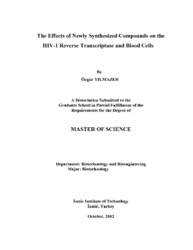Please use this identifier to cite or link to this item:
https://hdl.handle.net/11147/3755Full metadata record
| DC Field | Value | Language |
|---|---|---|
| dc.contributor.advisor | Güneş, Hatice | - |
| dc.contributor.author | Yılmazer, Özgür | - |
| dc.date.accessioned | 2014-07-22T13:52:18Z | - |
| dc.date.available | 2014-07-22T13:52:18Z | - |
| dc.date.issued | 2002 | - |
| dc.identifier.uri | http://hdl.handle.net/11147/3755 | - |
| dc.description | Thesis (Master)--Izmir Institute of Technology, Biotechnology, Izmir, 2002 | en_US |
| dc.description | Includes bibliographical references (leaves: 62-70) | en_US |
| dc.description | Text in English; Abstract: Turkish and English | en_US |
| dc.description | ix, 70 leaves | en_US |
| dc.description.abstract | Acquired Immunodeficiency Syndrome (AIDS) is a result of replication of Human Immunodeficiency Virus (HIV-1) in an infected host. Reverse transcriptase (RT) enzyme of HIV-1 is a multifunctional enzyme in the life cycle of the virus. Even though many compounds have been developed against different aspects of HIV-1, RT enzyme is a prime target for the development of drugs against HIV-1 because eucaryotic cells do not have RT activity. In order to develop new therapeutic agents against HIV-1, nineteen newly synthesized compounds were analyzed for their effects on inhibition of RT activity as well as their effects on viability, proliferation, and activity of peripheral blood mononuclear cells (PBMC). Finally, mutagenic effects of the compounds were investigated. Results indicated that AVM 002 and AVM 014 were the most promising compounds with 51% and 43% inhibitory effects, respectively on RT enzyme at 100.M concentration. The compounds AVM 001, AVM 010, AVM 011, AVM 015 and AVM 019 also showed inhibitory effects between 24% and 40% at 100.M concentration.AVM 002 did not cause any toxic effect on cell viability, proliferation and activation until 500.M concentration. Similar to AVM 002, AVM 014 did not show any toxic effect on the cell viability until 500.M and 1000.M at the and of 24 hour incubation; however, AVM 014 at 500.M and 1000.M resulted in 2-fold decrease in the cell viability after 48 and 72 hour incubation, compared to the control. Unlike AVM 002, AVM 014 gave rise to 3,4-fold decrease in cell activity at the end of second and third day incubation. Moreover, among all of the tested compounds, AVM 010 was the most toxic at 500.M and 1000.M compared to the control. Furthermore, all the compounds did not show any mutagenic effect on Salmonella typhimurium TA 100 and TA 102 strains.In summary, the results indicate that AVM 002 and AVM 014 is the best candidate to be improved in order to reach higher RT enzyme inhibitory effect and decreased cytotoxicity profile by slight modifications in compound structure. | en_US |
| dc.language.iso | en | en_US |
| dc.publisher | Izmir Institute of Technology | en_US |
| dc.rights | info:eu-repo/semantics/openAccess | en_US |
| dc.subject.lcc | QR414.6.H58 .Y51 2002 | en |
| dc.subject.lcsh | HIV (Viruses) | en |
| dc.subject.lcsh | HIV (Viruses)--Enzymes | en |
| dc.subject.lcsh | Reverse transcriptase | en |
| dc.title | The Effects of Newly Synthesized Compounds on the Hiv-1 Reverse Transcriptase and Blood Cells | en_US |
| dc.type | Master Thesis | en_US |
| dc.institutionauthor | Yılmazer, Özgür | - |
| dc.department | Thesis (Master)--İzmir Institute of Technology, Bioengineering | en_US |
| dc.relation.publicationcategory | Tez | en_US |
| dc.identifier.wosquality | N/A | - |
| dc.identifier.scopusquality | N/A | - |
| item.openairecristype | http://purl.org/coar/resource_type/c_18cf | - |
| item.grantfulltext | open | - |
| item.fulltext | With Fulltext | - |
| item.cerifentitytype | Publications | - |
| item.openairetype | Master Thesis | - |
| item.languageiso639-1 | en | - |
| Appears in Collections: | Master Degree / Yüksek Lisans Tezleri | |
Files in This Item:
| File | Description | Size | Format | |
|---|---|---|---|---|
| T000123.pdf | MasterThesis | 471.88 kB | Adobe PDF |  View/Open |
CORE Recommender
Items in GCRIS Repository are protected by copyright, with all rights reserved, unless otherwise indicated.